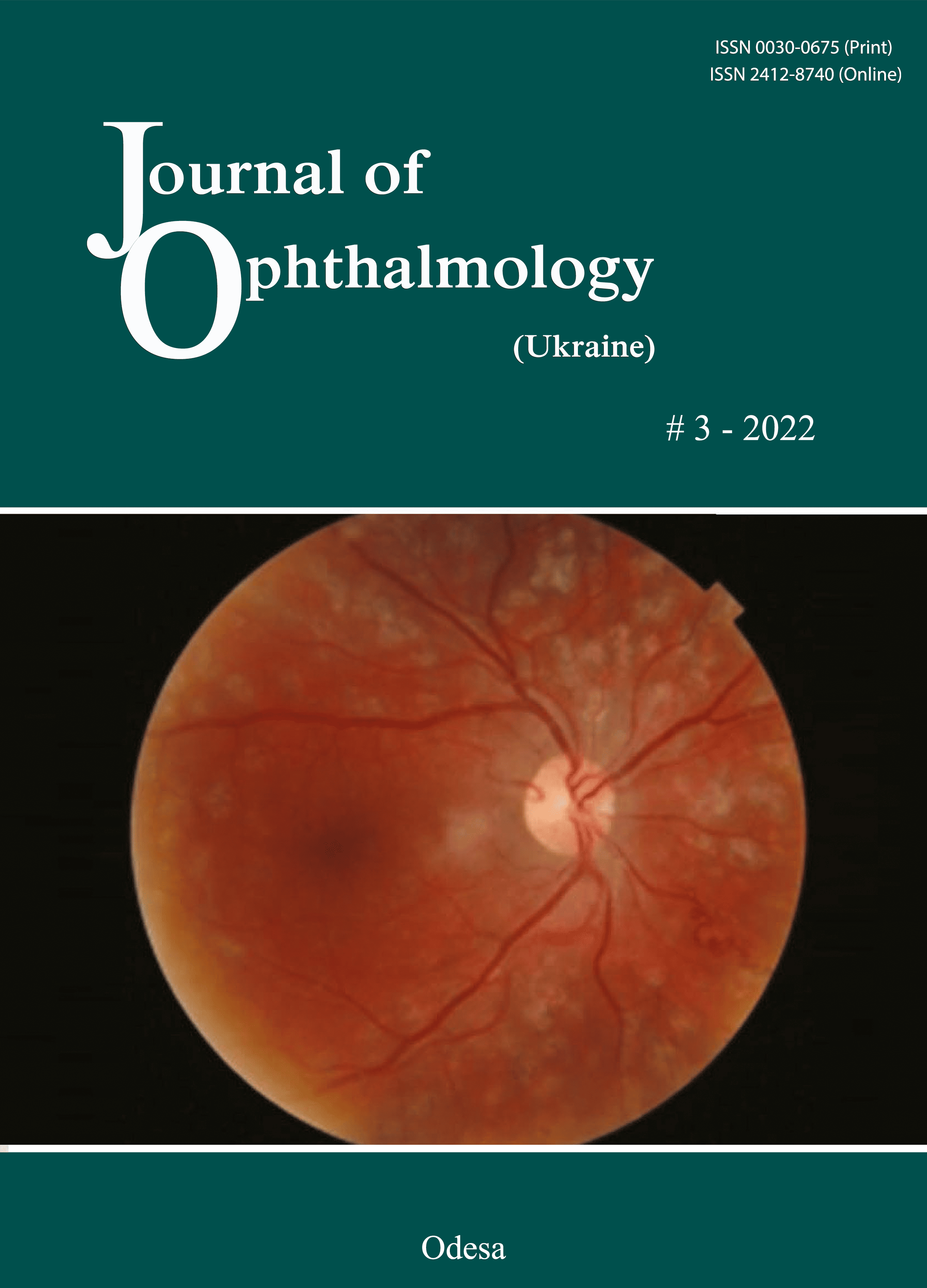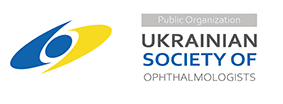Influence of corvitin and metformin on biochemical changes in lacrimal glands of rats during water avoidance stress modeling
DOI:
https://doi.org/10.31288/oftalmolzh202233944Keywords:
corvitin, metformin, lacrimal glands, water avoidance stressAbstract
Background. Dry eye disease is a multifactorial condition, which is characterized by impairment of tear film formation. Lacrimal glands metabolism plays a critical role in dry eye disease. Emotional stress may impair lacrimal glands function.
Purpose. We aimed to study production of nitric oxide from constitutive and inducible NO-synthases, activity of arginases and oxidative stress markers in lacrimal glands of rats during modeling of water avoidance stress (WAS) and its correction by metformin and corvitin.
Material and methods. We concluded our experiment on 36 adult male rats of Wistar line weighing 190-240 g. Animals were divided into 6 groups consisting from 6 animals each, namely: control group, WAS group, group of correction by metformin (200 mg/kg) and group of correction by corvitin (10 mg/kg) during WAS modeling. And two drug-control groups.
Results. WAS leads to increased activity of inducible NO-synthase, superoxide dismutase, catalase and concentration of MDA by 1.59, 1.93, 1.97 and 1.28 times respectively. Metformin and corvitin decreased activity of inducible NO-synthase by 8.25 and 8.5 times respectively, concentration of MDA decreased by 1.35 and 1.26 times respectively. Activities of superoxide dismutase did not change after introduction of metformin and corvitin. Metformin decreased catalase activity by 1.47 and corvitin increased it by 1.55 times. Production of superoxide dropped during WAS by 1.59 times and was increased to level below or equal that of control animals with introduction of metformin and corvitin.
Conclusion. Increased activity of inducible NO-synthase during WAS is a possible reason of tissue damage in lacrimal glands of rats. Introduction of metformin or corvitin during WAS are an effective means for correction of tissue damage in lacrimal glands of rats due to their ability to lower increased inducible NO-synthase activity.
References
1.Stapleton F, Alves M, Bunya VY, Jalbert I, Lekhanont K, Malet F, Na KS, Schaumberg D, Uchino M, Vehof J, Viso E, Vitale S, Jones L. TFOS DEWS II Epidemiology Report. Ocul Surf. 2017; 15(3): 334-365. https://doi.org/10.1016/j.jtos.2017.05.003
2.Rouen PA, White ML. Dry Eye Disease: Prevalence, Assessment, and Management. Home Healthc Now. 2018; 36(2): 74-83. https://doi.org/10.1097/NHH.0000000000000652
3.Seen S, Tong L. Dry eye disease and oxidative stress. Acta Ophthalmol. 2018; 96(4): e412-e420. https://doi.org/10.1111/aos.13526
4.Dogru M, Kojima T, Simsek C, Tsubota K. Potential Role of Oxidative Stress in Ocular Surface Inflammation and Dry Eye Disease. Invest Ophthalmol Vis Sci. 2018; 59(14): DES163-DES168. https://doi.org/10.1167/iovs.17-23402
5.Park B, Jo K, Lee TG, Hyun SW, Kim JS, Kim CS. Polydatin Inhibits NLRP3 Inflammasome in Dry Eye Disease by Attenuating Oxidative Stress and Inhibiting the NF-κB Pathway. Nutrients. 2019; 11(11): 2792. https://doi.org/10.3390/nu11112792
6.Hyon JY, Yang HK, Han SB. Association between Dry Eye Disease and Psychological Stress among Paramedical Workers in Korea. Sci Rep. 2019; 9(1): 3783. https://doi.org/10.1038/s41598-019-40539-0
7.Cortes M, Esposito G, Sacco R, Gillet VB, Ianni A, Micera A. NGF and iNOS Changes in Tears from Video Display Terminal Workers. Curr Eye Res. 2018; 43(9): 1119-1125. https://doi.org/10.1080/02713683.2018.1475014
8.Kim J, Kim YS, Park SH. Metformin as a Treatment Strategy for Sjögren's Syndrome. Int J Mol Sci. 2021; 22(13): 7231. https://doi.org/10.3390/ijms22137231
9.Abengózar-Vela A, Schaumburg CS, Stern ME, Calonge M, Enríquez-de-Salamanca A, González-García MJ. Topical Quercetin and Resveratrol Protect the Ocular Surface in Experimental Dry Eye Disease. Ocul Immunol Inflamm. 2019;27(6):1023-1032. https://doi.org/10.1080/09273948.2018.1497664
10.Yamamoto K, Takao T, Nakayama J, Kiuchi H, Okuda H, Fukuhara S, Yoshioka I, Matsuoka Y, Miyagawa Y, Tsujimura A, Nonomura N. Water avoidance stress induces frequency through cyclooxygenase-2 expression: a bladder rat model. Int J Urol. 2012; 19(2): 155-62. https://doi.org/10.1111/j.1442-2042.2011.02905.x
11.Talash VV, Kostenko VO. Effect of inhibitors of nuclear factor κB activation upon metabolism and hemocoagulation under modeled metabolic syndrome. Pharmacology and drug toxicology. 2015; 43(2): 83-9. (in Ukrainian)
12.Khmil' DO, Kostenko VO. Effect of L-arginine and corvitin on oxidative-nitrosative stress in skin of rats exposed to excessive sodium nitrate. Fiziolohichnyi zhurnal. 2017; 63(6): 53-9. (in Ukrainian) https://doi.org/10.15407/fz63.06.053
13.Akimov OYe, Kostenko VO. Functioning of nitric oxide cycle in gastric mucosa of rats under excessive combined intake of sodium nitrate and fluoride. Ukr. Biochem. J. 2016; 88(6):70-75. https://doi.org/10.15407/ubj88.06.070
14.Yelins'ka AM, Akimov OYe, Kostenko VO. Role of AP-1 transcriptional factor in development of oxidative and nitrosative stress in periodontal tissues during systemic inflammatory. Ukr.Biochem.J. 2019; 91(1): 80-5. https://doi.org/10.15407/ubj91.01.080
15.Kostenko VO, Tsebrzhins'kii OI. Production of superoxide anion radical and nitric oxide in renal tissues sutured with different surgical suture material. Fiziolohichnyi Zhurnal (Kiev, Ukraine : 1994). 2000 ;46(5):56-62. (in Ukraininan).
16.Brusov OS, Gerasimov AM, Panchenko LF. Effect of Natural Inhibitors of Radical Reactions on Adrenaline Autooxidation. Bulletin of Experimental Biology and Medicine. 1976; 1: 33-35. (In Russian). https://doi.org/10.1007/BF00800160
17.Korolyuk MA, Ivanova LI, Mayorova IG. Method for determining catalase activity. Laboratory work. 1988; 1: 16-19. (In Russian).
18.Gérard-Monnier D, Erdelmeier I, Régnard K, Moze-Henry N, Yadan JC, Chaudière J. Reactions of 1-Methyl-2-phenylindole with Malondialdehyde and 4-Hydroxyalkenals. Analytical Applications to a Colorimetric Assay of Lipid Peroxidation. Chem. Res. Toxicol. 1998;11(10):1176-83. https://doi.org/10.1021/tx9701790
19.Bartesaghi S, Radi R. Fundamentals on the biochemistry of peroxynitrite and protein tyrosine nitration. Redox Biol. 2018; 14: 618-625. https://doi.org/10.1016/j.redox.2017.09.009
20.Jones AM, Vanhatalo A, Seals DR, Rossman MJ, Piknova B, Jonvik KL. Dietary Nitrate and Nitric Oxide Metabolism: Mouth, Circulation, Skeletal Muscle, and Exercise Performance. Med Sci Sports Exerc. 2021 Feb 1;53(2):280-294. https://doi.org/10.1249/MSS.0000000000002470
21.Kapil V, Khambata RS, Jones DA, Rathod K, Primus C, Massimo G, Fukuto JM, Ahluwalia A. The Noncanonical Pathway for In Vivo Nitric Oxide Generation: The Nitrate-Nitrite-Nitric Oxide Pathway. Pharmacol Rev. 2020 Jul;72(3):692-766. https://doi.org/10.1124/pr.120.019240
22.Soydas T, Yaprak Sarac E, Cinar S, Dogan S, Solakoglu S, Tuncdemir M, Kanigur Sultuybek G. The protective effects of metformin in an in vitro model of aging 3T3 fibroblast under the high glucose conditions. J Physiol Biochem. 2018; 74(2): 273-281. https://doi.org/10.1007/s13105-018-0613-5
23.Batandier C, Poyot T, Marissal-Avry N, Couturier K, Canini F, Roussel AM, Hininger-Favier I. Acute emotional stress and high fat/high fructose diet modulate brain oxidative damage through NrF2 and uric acid in rats. Nutr Res. 2020; 79: 23-34. https://doi.org/10.1016/j.nutres.2020.05.009
24.Singh S, Singh DK, Meena A, Dubey V, Masood N, Luqman S. Rutin protects t butyl hydroperoxide-induced oxidative impairment via modulating the Nrf2 and iNOS activity. Phytomedicine. 2019; 55: 92-104. https://doi.org/10.1016/j.phymed.2018.07.009
Downloads
Published
How to Cite
Issue
Section
License
Copyright (c) 2025 Є. К. Мацицька, О. Є Акімов, A. O. Микитенко

This work is licensed under a Creative Commons Attribution 4.0 International License.
This work is licensed under a Creative Commons Attribution 4.0 International (CC BY 4.0) that allows users to read, download, copy, distribute, print, search, or link to the full texts of the articles, or use them for any other lawful purpose, without asking prior permission from the publisher or the author as long as they cite the source.
COPYRIGHT NOTICE
Authors who publish in this journal agree to the following terms:
- Authors hold copyright immediately after publication of their works and retain publishing rights without any restrictions.
- The copyright commencement date complies the publication date of the issue, where the article is included in.
DEPOSIT POLICY
- Authors are permitted and encouraged to post their work online (e.g., in institutional repositories or on their website) during the editorial process, as it can lead to productive exchanges, as well as earlier and greater citation of published work.
- Authors are able to enter into separate, additional contractual arrangements for the non-exclusive distribution of the journal's published version of the work with an acknowledgement of its initial publication in this journal.
- Post-print (post-refereeing manuscript version) and publisher's PDF-version self-archiving is allowed.
- Archiving the pre-print (pre-refereeing manuscript version) not allowed.












